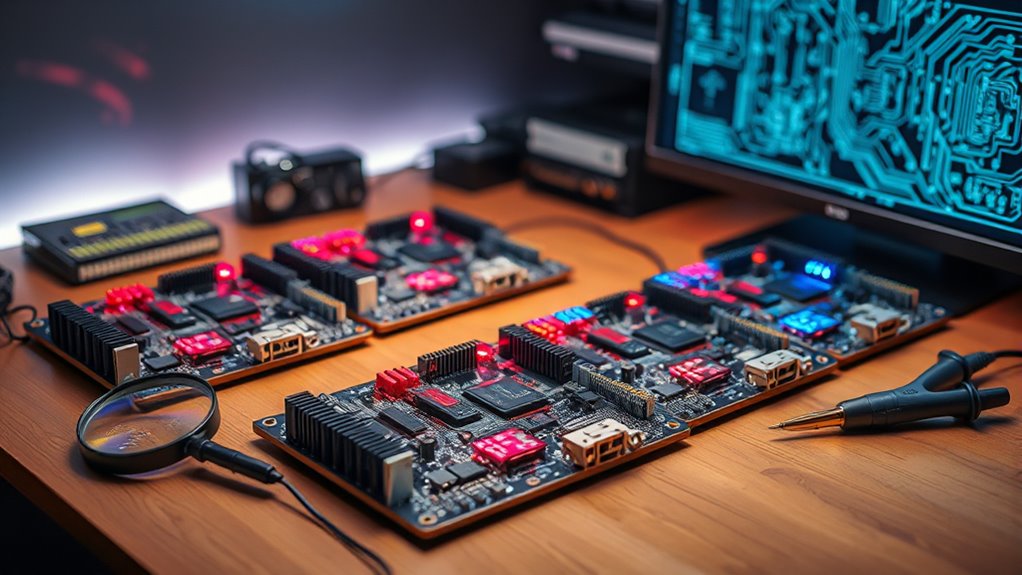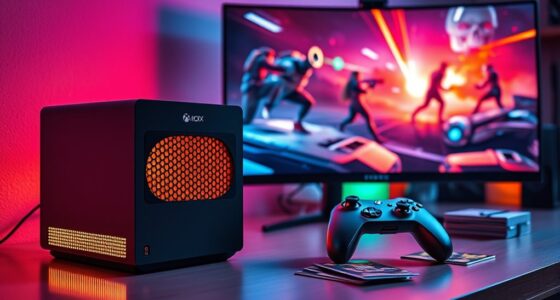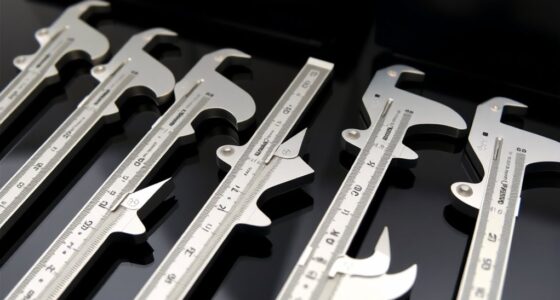If you’re after the top high-end FPGA development boards for complex projects in 2025, I’ve got you covered. From industrial-grade platforms with millions of logic cells to versatile boards like the Cyclone 10 and Artix-7, there’s a solution for every advanced application. These boards offer high-speed interfaces, extensive I/O, and strong support resources. Keep exploring to discover the perfect match for your demanding needs and long-term projects.
Key Takeaways
- Highlights cutting-edge FPGA boards with high logic capacity, advanced interfaces, and industrial-grade reliability suitable for complex, long-term projects.
- Covers a range of platforms from beginner-friendly to high-performance industrial solutions for diverse advanced applications.
- Details comprehensive hardware features, expansion options, and connectivity tailored for high-end research and development needs.
- Emphasizes robust software support, development tools, and resources available for sophisticated FPGA design workflows.
- Provides insights into cost, compatibility, and target user profiles for selecting top-tier FPGA development boards in 2025.
Cyclone 10 FPGA Development Board – CycloFlex
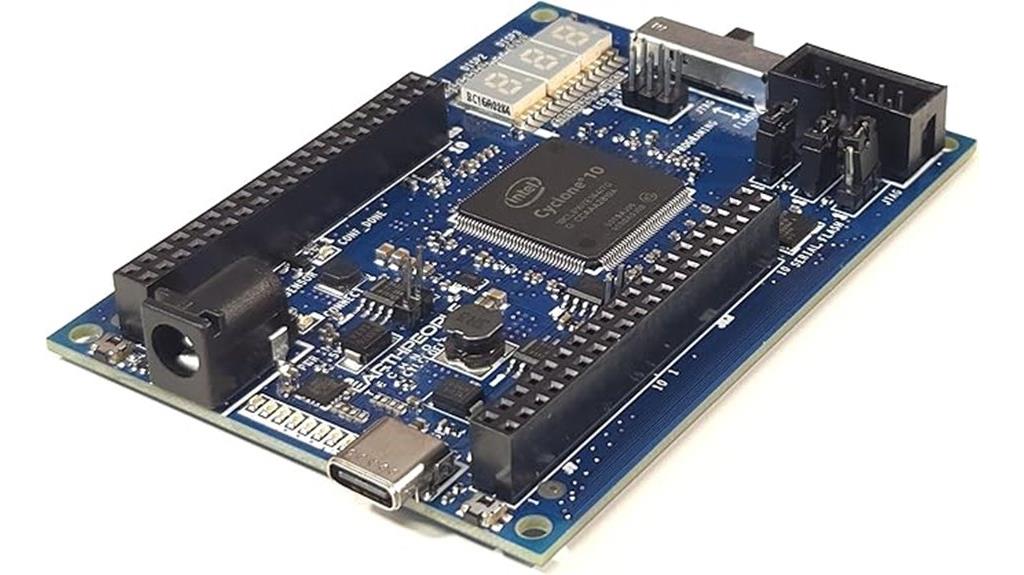
If you’re looking for a versatile FPGA development board capable of handling complex projects beyond the basics, the Cyclone 10 FPGA Development Board — CycloFlex is an excellent choice. Powered by the Altera Cyclone 10 FPGA, it offers 16,000 Logic Elements and 504Kbits of SRAM, supporting advanced designs like RISC-V processors with its 128Mbit Serial Flash. It features multiple output options, including three Seven Segment LED displays, an RGB LED, and eight user LEDs. With 65 I/O pins, a 50MHz clock, and flexible power options via USB-C or barrel jack, CycloFlex delivers robust performance for demanding FPGA projects.
Best For: hobbyists, students, and engineers seeking a versatile FPGA development platform for complex projects including RISC-V processors and advanced digital designs.
Pros:
- Supports advanced designs with 16,000 Logic Elements and 504Kbits SRAM memory.
- Flexible I/O options with 65 pins, multiple displays, and user LEDs for comprehensive interfacing.
- Multiple power options and comprehensive development resources including tutorials and source code.
Cons:
- First available date listed as April 14, 2025, which may be a future or incorrect date.
- Compact size may limit extensive expansion without additional accessories.
- Requires Windows 11, potentially limiting compatibility for some users.
Altera MAX10 FPGA Max Package – MaxPro + JTAG + Cable
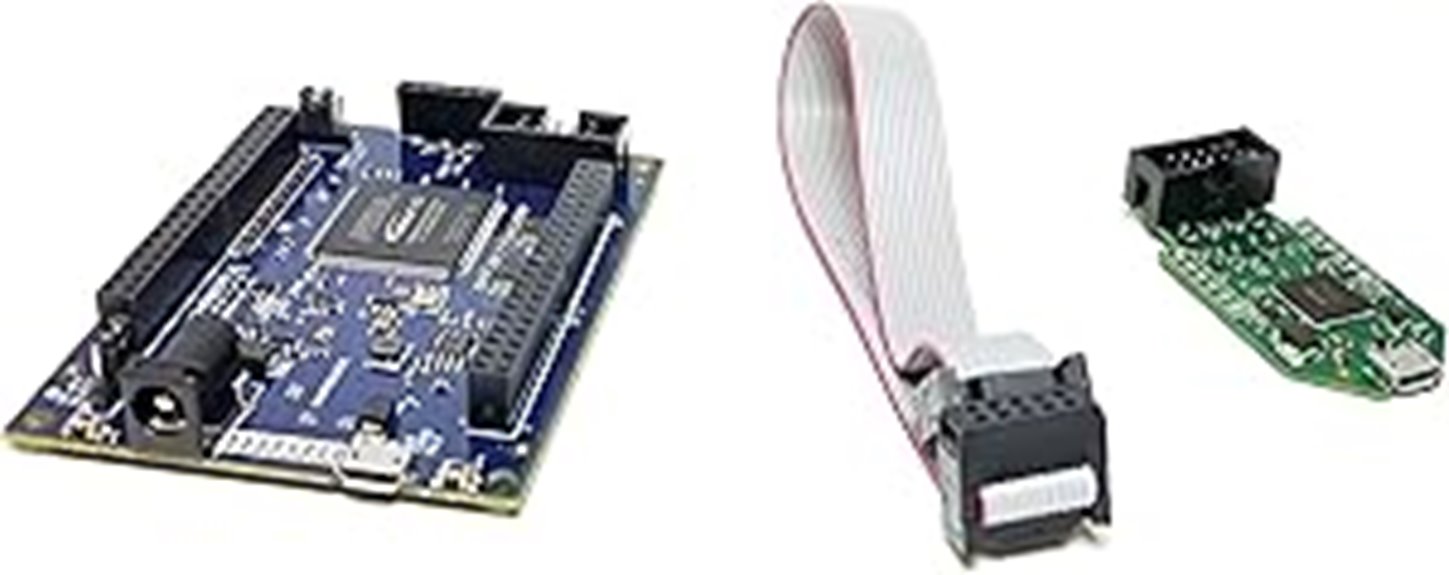
The Altera MAX10 FPGA Max Package—MaxPro with JTAG and cable stands out as an excellent choice for both beginners and experienced developers seeking a versatile, user-friendly platform. It features 4,000 Logic Elements, embedded memory, built-in flash, and eight analog inputs, making it suitable for various projects like sensor integration and audio analysis. The kit includes a JTAG programmer, 10-pin cable, and accessible I/O pins, simplifying programming and debugging. Powered by the free Quartus Prime Lite software, it offers extensive design tools. With extensive online resources and support, the MAX10 MaxPro is an ideal, reliable solution for advanced FPGA development in 2025.
Best For: hobbyists, students, and beginner to advanced FPGA developers seeking an accessible, versatile development platform with extensive support and resources.
Pros:
- User-friendly design with accessible I/O pins and integrated features for easy project setup
- Free, comprehensive Quartus Prime Lite software including design, synthesis, and simulation tools
- Includes JTAG programmer and cables, simplifying programming and debugging processes
Cons:
- Limited to 4,000 Logic Elements, which may be insufficient for highly complex designs
- Slightly larger dimensions may require more space in compact projects
- Requires familiarity with FPGA development tools, which could be challenging for complete beginners
Digilent Basys 3 FPGA Trainer Board
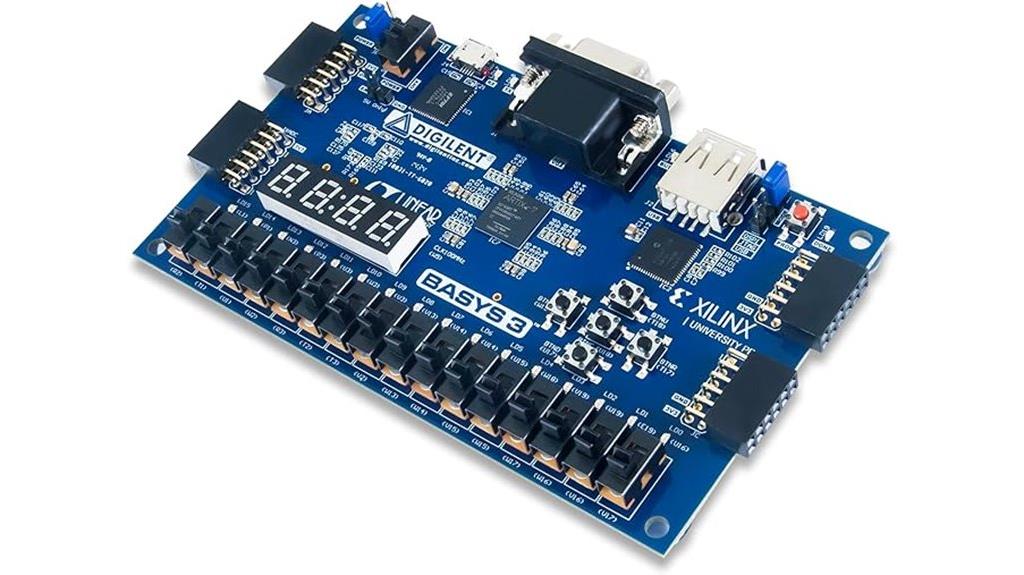
Designed with students and beginners in mind, the Digilent Basys 3 FPGA Trainer Board stands out as an accessible entry point into digital logic and FPGA development. It features the Xilinx Artix-7 FPGA, compatible with Vivado WebPACK, making programming straightforward. The board includes 16 switches, 16 LEDs, five pushbuttons, and four Pmod ports for expansion. Its compact size and lightweight design enhance portability. While lacking a micro USB cable and modern VGA output, it’s praised for ease of use, affordability, and solid documentation. Ideal for learning VHDL, Verilog, and digital design, it provides a practical foundation for progressing into more advanced FPGA projects.
Best For: beginners, students, and hobbyists looking to learn digital logic design and FPGA programming with an affordable and user-friendly platform.
Pros:
- Easy to set up and program using Vivado WebPACK with comprehensive documentation.
- Compact, lightweight, and portable, ideal for classroom and hobbyist environments.
- Includes multiple I/O interfaces like switches, LEDs, pushbuttons, and Pmod ports for expansion.
Cons:
- Lacks a micro USB cable, requiring users to purchase one separately.
- Outdated VGA output that needs adapters for modern HDMI displays.
- No onboard general RAM, limiting the implementation of complex soft microprocessor cores.
Digilent Nexys A7-100T: FPGA Trainer Board Recommended for ECE Curriculum
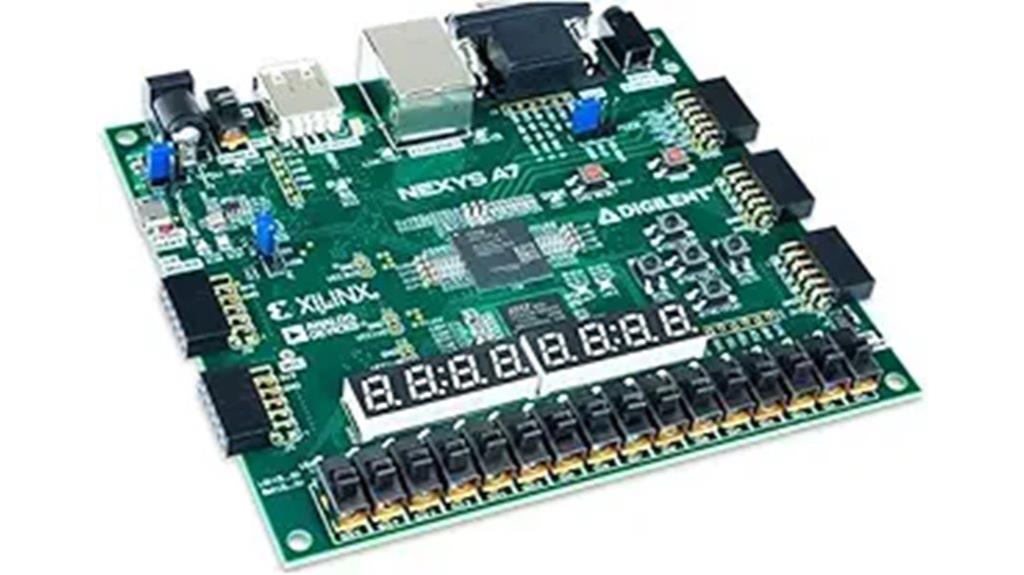
For electronics students and educators seeking a versatile and powerful FPGA development platform, the Digilent Nexys A7-100T stands out as an ideal choice within the top high-end FPGA boards for 2025. It features an Artix-7 FPGA with nearly 16,000 logic slices, high-speed block RAM, and clock management tiles supporting internal speeds over 450 MHz. The board supports DDR2 memory, multiple USB ports, and ARM-based quad-core processors, making it suitable for complex designs like CPU prototypes, custom ISA, and advanced projects. Its compact size, USB power, and extensive peripherals make it perfect for education, research, and prototyping in academic settings.
Best For: electronics students, educators, and hobbyists seeking a high-performance FPGA platform for complex design, prototyping, and FPGA development projects.
Pros:
- Powerful Artix-7 FPGA with nearly 16,000 logic slices and high-speed internal clocks over 450 MHz.
- Versatile peripherals including DDR2 memory, multiple USB ports, and ARM-based quad-core processors.
- Compact, portable, and USB-powered design ideal for educational use, research, and field applications.
Cons:
- Lack of built-in support for 16-bit VGA color (RGB565), requiring external modifications for advanced display features.
- No included instructions or basic setup guides, necessitating independent research and datasheet downloads.
- Limited internal DDR RAM (128MB) compared to similar boards with higher memory capacity (e.g., 256MB).
Cyclone 10 FPGA Development Board – CycloFlex
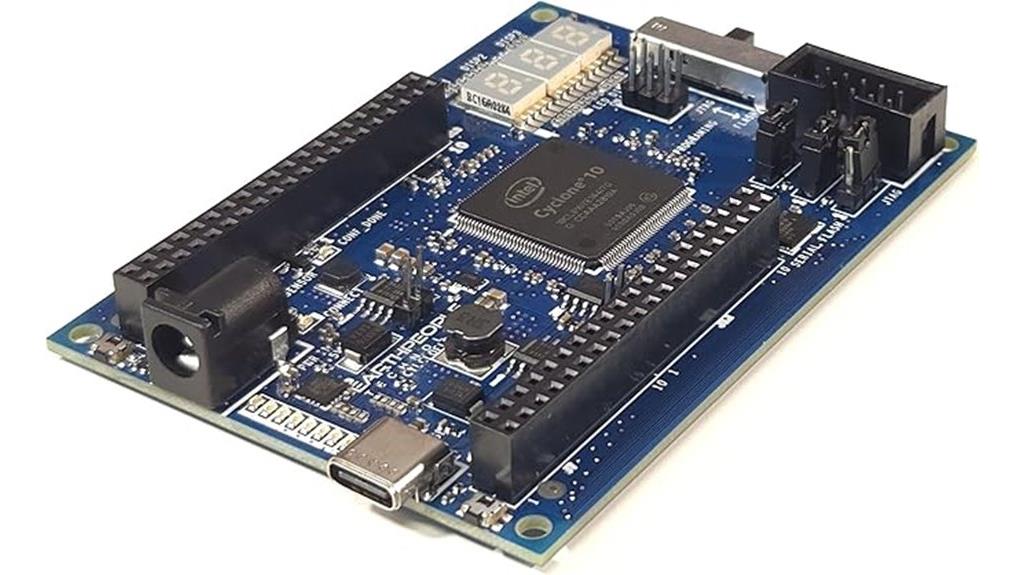
If you’re tackling complex FPGA projects and need a versatile development board, CycloFlex stands out with its powerful Cyclone 10 FPGA housing 16,000 Logic Elements and 504Kbits of SRAM. It features a 128Mbit Serial Flash chip for storing user code, enabling the FPGA to operate as a RISC-V soft processor. The board offers extensive I/O options, including 65 accessible inputs/outputs, pushbuttons, seven segment displays, an RGB LED, and user LEDs for advanced interfacing. With a 50MHz oscillator and flexible clock management, it supports precise timing. Power options include USB-C or Barrel Connector, and extensive documentation and support make it ideal for high-end, demanding projects.
Best For: enthusiasts and professionals tackling complex FPGA projects who require a versatile and high-performance development platform.
Pros:
- Equipped with a powerful Cyclone 10 FPGA featuring 16,000 Logic Elements and 504Kbits of SRAM for advanced design capabilities
- Extensive I/O options including 65 accessible inputs/outputs, pushbuttons, displays, and LEDs for versatile interfacing
- Supports precise clock management with a 50MHz oscillator and multiple DLLs, enabling flexible timing solutions
Cons:
- Slightly larger dimensions may limit portability for some users
- First availability date of April 14, 2025, suggests it is a future product and may not be immediately accessible
- Higher complexity may require a steeper learning curve for beginners in FPGA development
Sipeed Tang Primer 25K FPGA Development Board with MIPI and HDMI
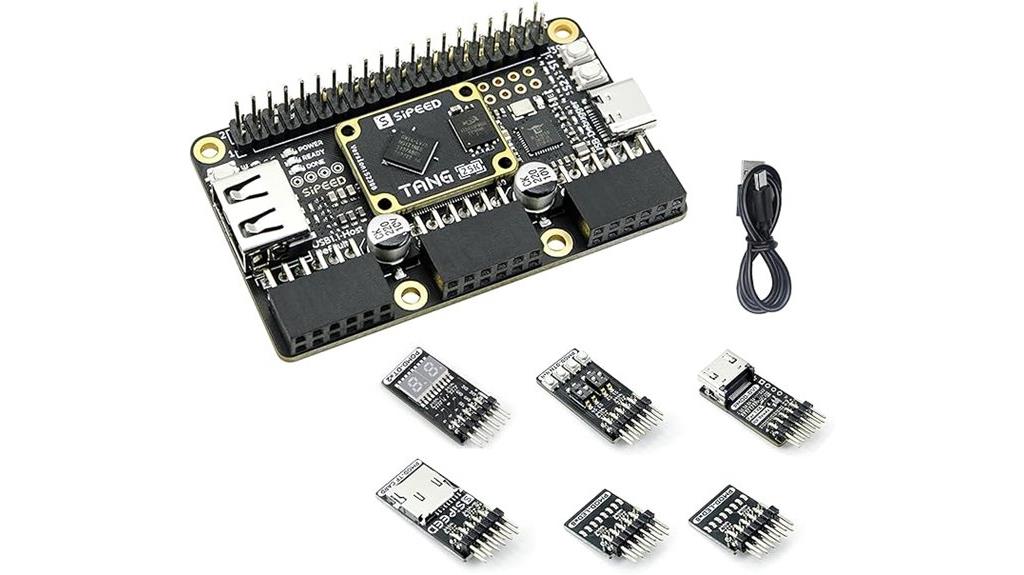
The Sipeed Tang Primer 25K FPGA Development Board stands out with its compact size and versatile connectivity options, making it an excellent choice for advanced FPGA projects in 2025. Its GW5A-LV25MG121 FPGA supports 23K LUTs and 4-lane MIPI interfaces, ideal for camera and display applications. The board includes onboard NOR Flash, high-speed JTAG and UART debugging, and supports DDR3/DDR4 RAM. Its multiple interfaces—USB-C, USB-A, PMODs, GPIO, DVP camera connectors—enable diverse project development. Designed for embedded systems, it’s perfect for FPGA education, multimedia, and networking projects, all within a small 64x40mm footprint.
Best For: FPGA enthusiasts, educators, and hobbyists seeking a compact, versatile development board for camera, display, and network applications in embedded systems.
Pros:
- Supports Gowin GW5A FPGA with 23K LUTs and 4-lane MIPI interface, ideal for high-performance digital designs
- Rich connectivity options including USB-C, USB-A, PMODs, GPIO, and DVP camera connectors for diverse project integration
- Open-source hardware with extensive documentation and onboard debugger, facilitating easy development and customization
Cons:
- Slightly limited size may restrict the complexity of some projects or expansion options
- Customer feedback indicates some difficulty with pin mapping instructions for FPGA and modules
- Requires a 5V power supply and may need additional peripherals for complete setup
JTAG Blaster – Intel/Altera FPGA CPLD JTAG Programmer
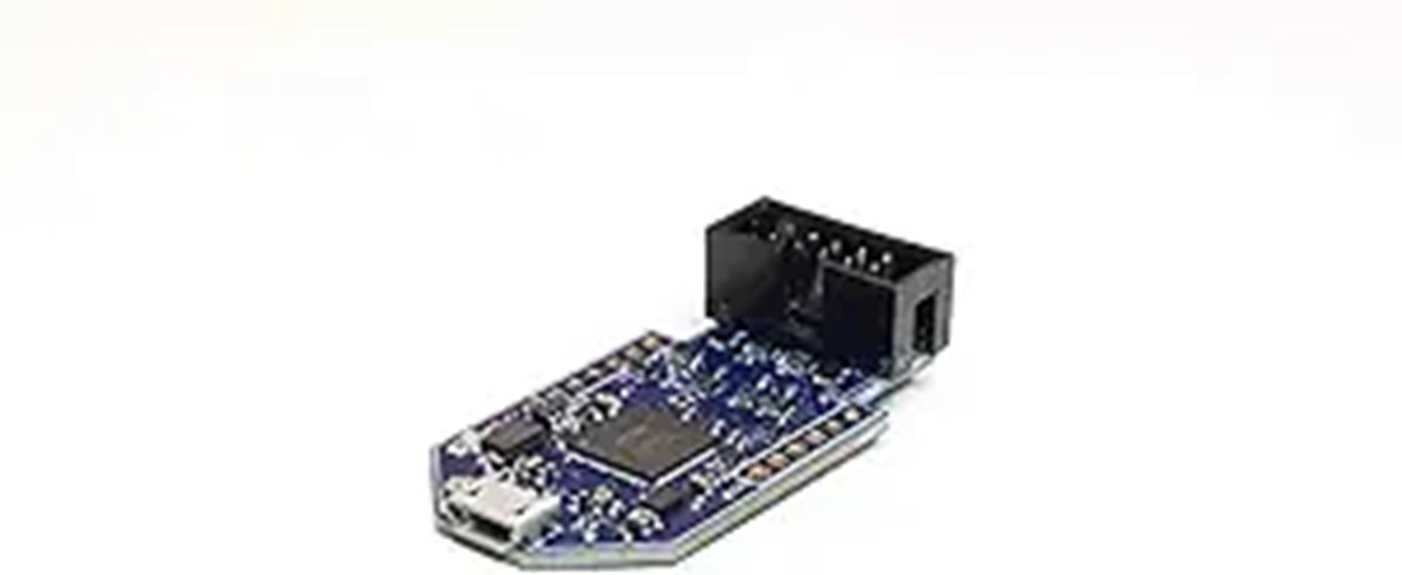
JTAG Blaster stands out as a compact, cost-effective JTAG programmer specifically tailored for enthusiasts and professionals working with Intel and Altera FPGA and CPLD devices. Made in the USA by Earth People Technology, it supports a wide range of chips, including MAX II, MAX V, MAX10, Cyclone, and Stratix series. Connecting via Micro-B USB, it offers a pin-compatible interface with the Intel/Altera USB Blaster and supports voltage levels from +1.8V to +5V. Its small size and simple design make it ideal for programming and debugging, but setup can require technical skills and troubleshooting to guarantee proper driver installation and connection.
Best For: electronics hobbyists, engineers, and professionals working with Intel/Altera FPGA and CPLD devices who need an affordable, compact, and versatile JTAG programmer requiring technical setup.
Pros:
- Supports a wide range of Intel/Altera FPGA and CPLD chips, including MAX II, MAX V, MAX10, Cyclone, and Stratix series.
- Compact and lightweight design, measuring only 1.85 x 0.95 x 0.4 inches and weighing 2 ounces.
- Utilizes standard FTDI drivers and offers pin-for-pin compatibility with the Intel/Altera USB Blaster, providing a cost-effective solution.
Cons:
- Setup can be challenging, often requiring technical troubleshooting and driver configuration.
- Proper connection and powered device detection are essential; no success indication until everything is correctly aligned.
- Customer reviews indicate mixed experiences, with some users encountering difficulties during installation and operation.
Digilent Zybo Z7: Zynq-7000 ARM/FPGA SoC Development Board (Zybo Z7-10)
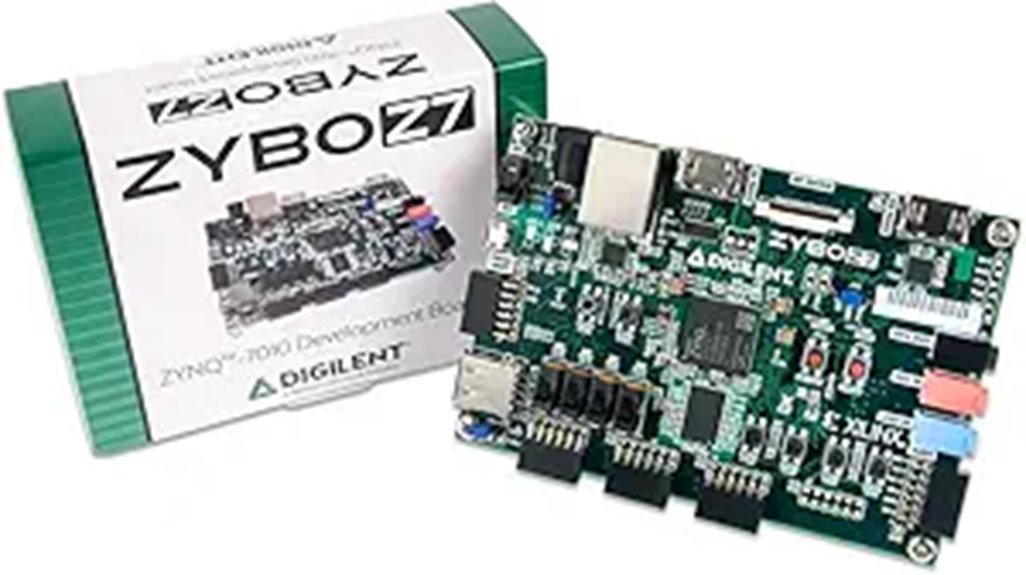
For those tackling complex embedded projects in 2025, the Digilent Zybo Z7 stands out thanks to its powerful Zynq-7000 AP SoC, which combines an ARM Cortex-A9 processor with FPGA fabric. The Zybo Z7-10 variant features a Xilinx XC7Z010 FPGA, dual-core 667 MHz ARM CPU, DDR3 SDRAM, and over 30 I/O pins. It includes six push buttons, switches, LEDs, and expansion options like Pmod ports and analog pairs. Supporting Linux and wireless connectivity, it’s ideal for multimedia, connectivity, and custom circuit development. Its all-encompassing documentation and community support make it suitable for both learning and professional prototyping, offering a versatile platform for advanced FPGA projects.
Best For: enthusiasts, students, and professionals seeking a versatile FPGA development platform for multimedia, connectivity, and embedded system projects.
Pros:
- Features a powerful Zynq-7000 AP SoC with ARM Cortex-A9 and FPGA fabric for flexible applications
- Rich I/O options including over 30 FPGA pins, Pmod connectors, and analog differential pairs
- Extensive documentation, tutorials, and community support facilitate learning and development
Cons:
- Steep learning curve for beginners unfamiliar with FPGA and embedded Linux development
- No included cables, requiring users to purchase micro USB cables separately
- Limited to 30 I/O pins in the Z7-10 variant, which may restrict complex designs compared to higher-end models
Arty A7 FPGA Development Board for Makers and Hobbyists
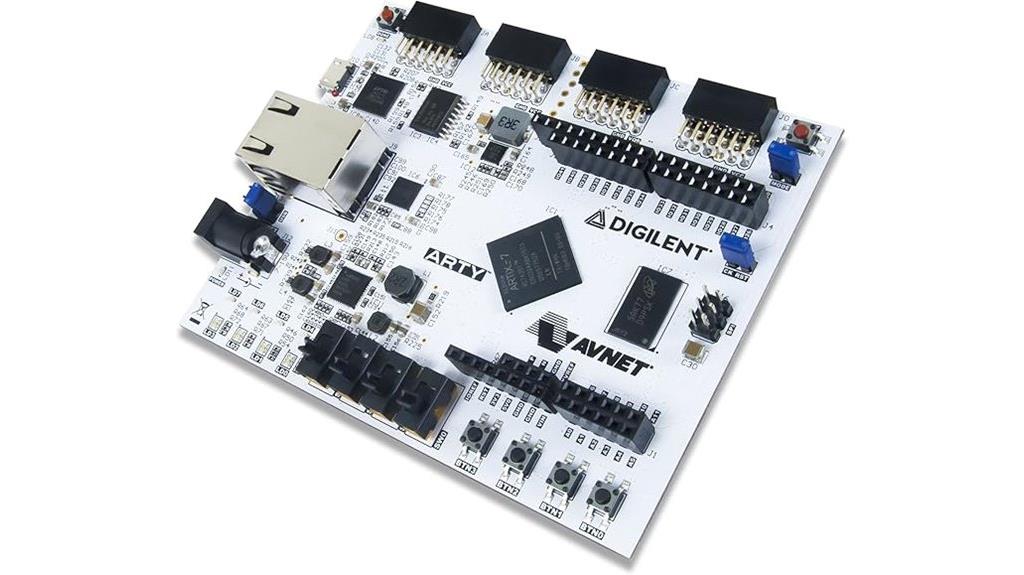
If you’re a maker or hobbyist seeking an accessible yet powerful FPGA development platform, the Arty A7-35T stands out with its Xilinx Artix-7 FPGA and Arduino-compatible expansion socket. Compact at 4 x 3 inches and weighing just over half an ounce, it offers 2GB LPDDR RAM at 667 MHz, running on Linux OS. Supported by free Xilinx tools, including two eBooks and a Vivado license voucher, it’s ideal for learning and prototyping. Praised for reliability and affordability, it’s a versatile choice for educational purposes and creative projects. Proper handling and protective cases are recommended to guarantee longevity during use and transit.
Best For: makers and hobbyists seeking an accessible, powerful FPGA platform for learning, prototyping, and creative projects.
Pros:
- Supports Xilinx Artix-7 FPGA technology with ample 2GB LPDDR RAM at 667 MHz.
- Comes with free FPGA development tools, eBooks, and a Vivado license voucher, enhancing learning and design capabilities.
- Compact, lightweight design with an Arduino-compatible expansion socket ideal for prototyping and versatile applications.
Cons:
- Requires careful handling and protective cases to prevent damage during transit and use.
- Limited to one processor from Xilinx, which may restrict certain high-performance applications.
- Some early shipments may experience delays or damage, necessitating proper shipping and protective measures.
Altera MAX10 FPGA Development Board – MaxProLogic
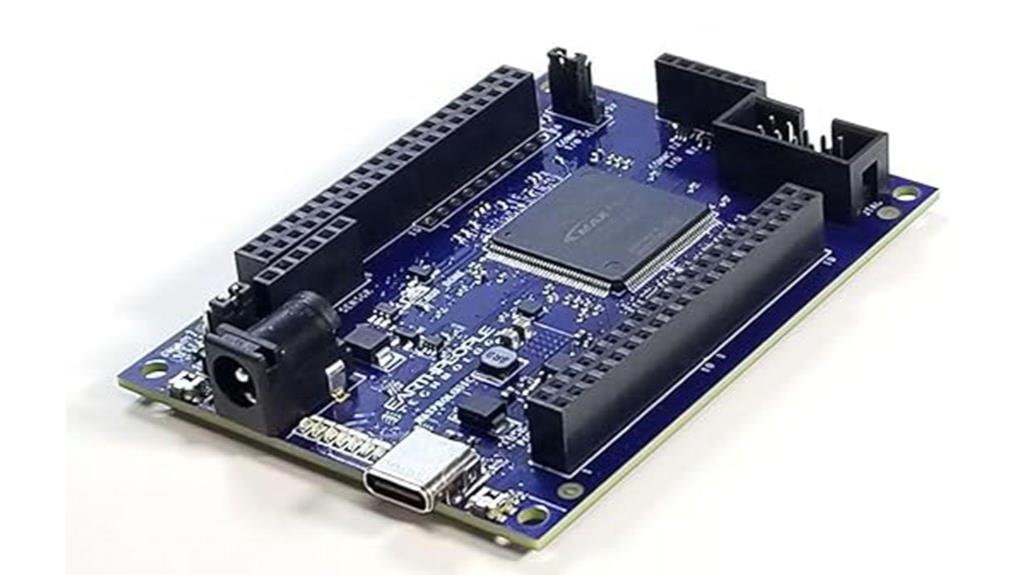
The Altera MAX10 FPGA Development Board – MaxProLogic stands out as an accessible option for intermediate users seeking a flexible and cost-effective FPGA platform. It features a 10M04SA FPGA with 4,000 logic elements, 200Kbits of embedded memory, and built-in configuration flash. The board includes 8 analog inputs, 65 I/O connectors, LEDs, pushbuttons, and sensors, supporting digital design and learning from beginner to advanced levels. It leverages free Quartus Prime Lite software, making development straightforward. While praised for its I/O and ease of use, some users report issues like unreliable configuration and limited onboard features, making it better suited for those with some FPGA experience.
Best For: intermediate users seeking a flexible, cost-effective FPGA development platform capable of supporting digital design projects with room for customization and learning.
Pros:
- User-friendly design with extensive I/O options suitable for various projects
- Supports free Quartus Prime Lite software for synthesis, simulation, and development
- Includes analog inputs, sensors, and built-in configuration flash for versatile applications
Cons:
- Reliability issues with FPGA configuration and potential hardware failures reported by users
- Limited onboard features such as minimal user inputs and absence of industry-standard PMOD ports
- External programming required, making initial setup more complex for beginners
Altera Cyclone IV FPGA Development Board – DueProLogic
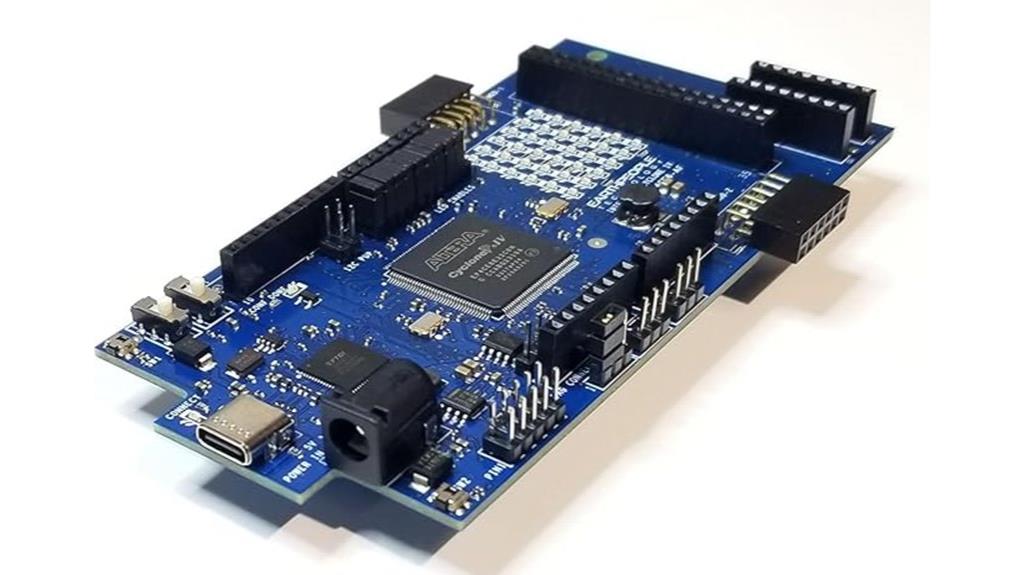
The Altera Cyclone IV FPGA Development Board by DueProLogic stands out as an ideal choice for electronics students, hobbyists, and entrepreneurs seeking an accessible yet powerful platform for learning and prototyping. It features 6,000 Logic Elements, two clock multipliers, 20KB SRAM, and 70 I/O pins with stackable headers. Programming is simple via a USB-C cable, supporting onboard or external JTAG programming. The board includes a 6×6 LED array for visual projects, oscillators at 66MHz and 100MHz, and multiple connectors and switches. Despite some driver challenges, its versatility, all-encompassing tutorials, and hardware capabilities make it a solid choice for advanced FPGA development.
Best For: electronics students, hobbyists, and entrepreneurs seeking an accessible yet powerful FPGA development platform for learning, prototyping, and project development.
Pros:
- User-friendly programming via USB-C with onboard or external JTAG support
- Rich hardware features including 6,000 Logic Elements and a 6×6 LED array for visual projects
- Comprehensive tutorials and pre-synthesized projects that facilitate learning and experimentation
Cons:
- Driver installation and configuration can be complex and may require troubleshooting
- Potential hardware defects or shorts, leading to the need for replacements
- Programming .pof files can be time-consuming, and JTAG interfaces may not work seamlessly out-of-the-box
AMD Xilinx VU9P/VU13P FPGA Development Board (PZ-VU13P-KFB)
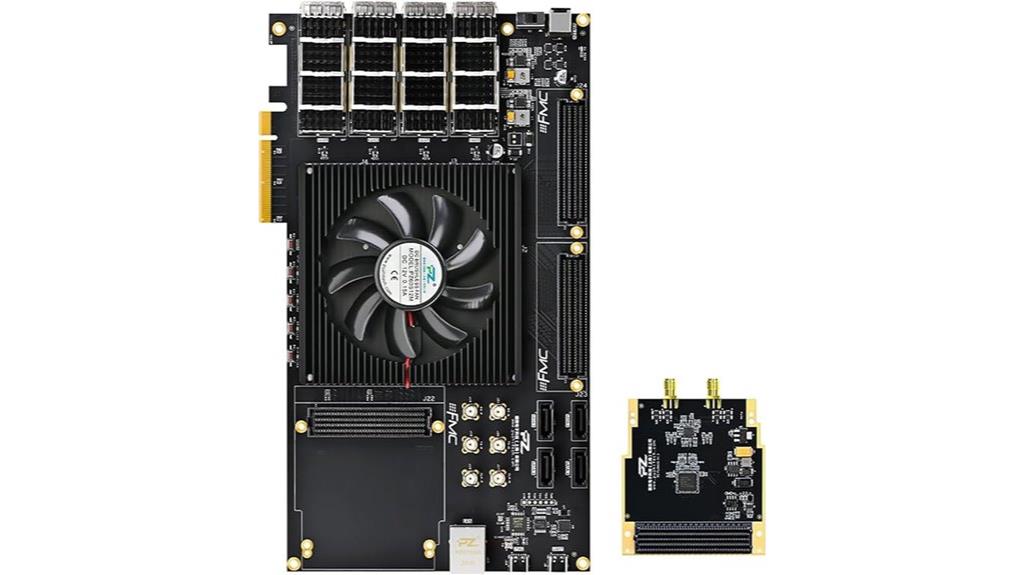
Designed for high-performance computing and data-intensive applications, the AMD Xilinx VU9P/VU13P FPGA Development Board (PZ-VU13P-KFB) features industrial-grade chips with up to 3.78 million logic cells and 12,288 DSP slices, making it ideal for advanced projects in AI, 5G, and HPC. It offers 8GB of dual-bank DDR4 memory, dual QSPI Flash, and multiple high-speed interfaces like PCIe Gen3 x8 and four 100G QSFP28 ports. Its compact form factor, robust temperature range, and industrial-grade durability guarantee reliable operation in demanding environments. This board’s extensive I/O options support complex system integration for cutting-edge applications.
Best For: researchers, engineers, and developers working on high-performance computing, AI, 5G, and HPC projects requiring industrial-grade FPGA solutions.
Pros:
- Provides up to 3.78 million logic cells and 12,288 DSP slices for complex processing tasks.
- Equipped with dual 8GB DDR4 memory and multiple high-speed interfaces for data-intensive applications.
- Compact design with industrial-grade durability, suitable for harsh environments from -40°C to +85°C.
Cons:
- May require advanced FPGA knowledge for optimal utilization and integration.
- Higher cost associated with high-end industrial-grade FPGA development boards.
- Limited expandability options beyond the provided high-speed ports and interfaces.
Development Board for ALTERA FPGA Cyclone II EP2C5T144
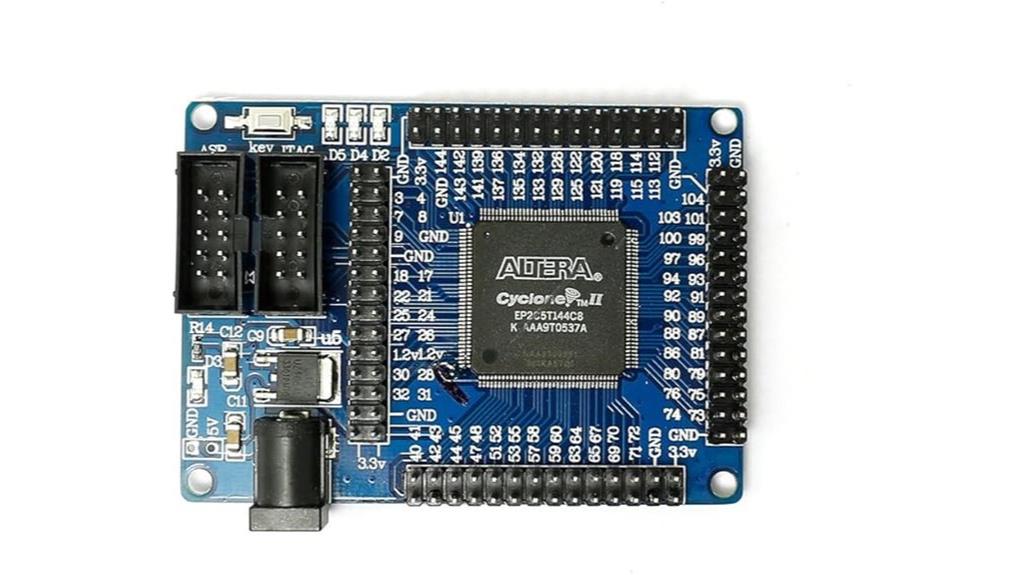
If you’re exploring cost-effective options for FPGA development, the Development Board for ALTERA FPGA Cyclone II EP2C5T144 is a solid choice. It features an onboard EP2C5T144 FPGA chip, a 4Mbit configuration EPROM, and accessible IO pins for customization. Its compact size makes it ideal for embedded system prototypes, supporting logic control, data acquisition, and signal processing. The board’s design includes high-quality tantalum capacitors for power filtering and an onboard reset switch. While it uses older hardware requiring Quartus II 13.0sp1, it remains popular for basic FPGA projects due to its affordability and straightforward features.
Best For: hobbyists and students seeking an affordable, straightforward FPGA development platform for basic embedded system prototyping and signal processing projects.
Pros:
- Cost-effective solution suitable for beginners and educational purposes
- Compact size with accessible IO pins for easy customization and extension
- Supports embedded CPU development and simple logic control
Cons:
- Uses older FPGA hardware requiring specific software version (Quartus II 13.0sp1)
- Limited support for newer development tools and peripherals
- Onboard button inputs may need proper pin configuration for reliable operation
FPGA Development Board Zynq UltraScale+ RFSoC xczu47dr
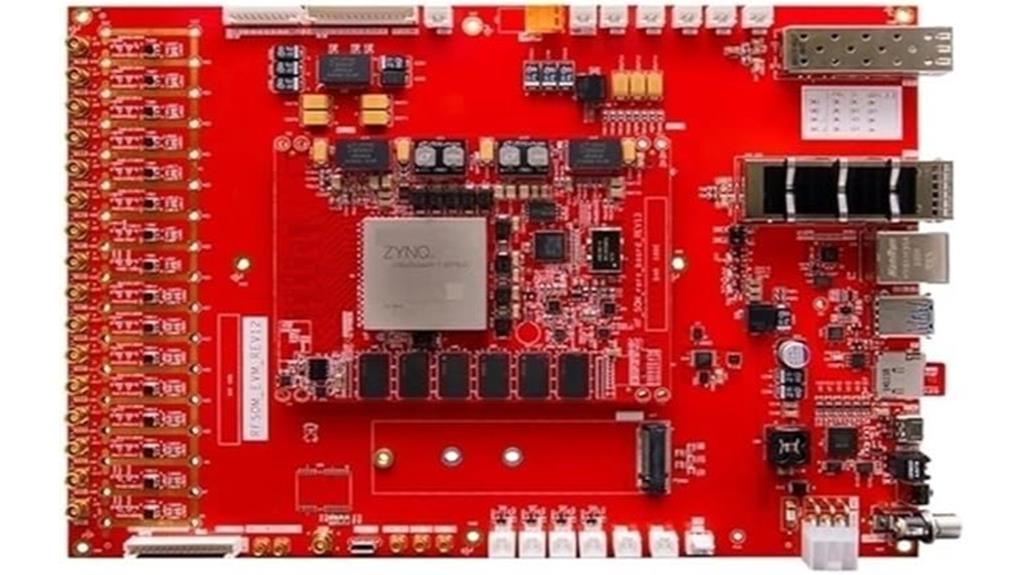
For advanced developers seeking exceptional performance and stability, the FPGA Development Board Zynq UltraScale+ RFSoC xczu47dr stands out as an ideal choice. Manufactured by RCTCBRZVTW, it’s designed for long-term use with easy installation and straightforward maintenance. Weighing just 2.2 pounds and compact at 0.39 inches each side, it’s versatile for various applications. The board’s robust build and support ensure reliable operation, while its design emphasizes correct usage to maximize lifespan. Released in April 2025, it’s perfect for demanding projects requiring high stability, making it a top-tier option in high-end FPGA development.
Best For: advanced developers and engineers seeking a high-performance, stable FPGA development platform for demanding long-term projects.
Pros:
- Offers exceptional performance with Zynq UltraScale+ RFSoC architecture for complex applications
- Compact, lightweight design (0.39 inches, 2.2 pounds) facilitates easy installation and integration
- Built for long-term stability with support for simple maintenance and correct usage practices
Cons:
- May require specialized knowledge for setup and optimal use
- Limited information on pricing and availability as of initial release date in April 2025
- Potential costs associated with repairs or returns if misused or tampered with, per warranty policies
USB104 A7: Artix-7 FPGA Development Board in PC/104 Form Factor
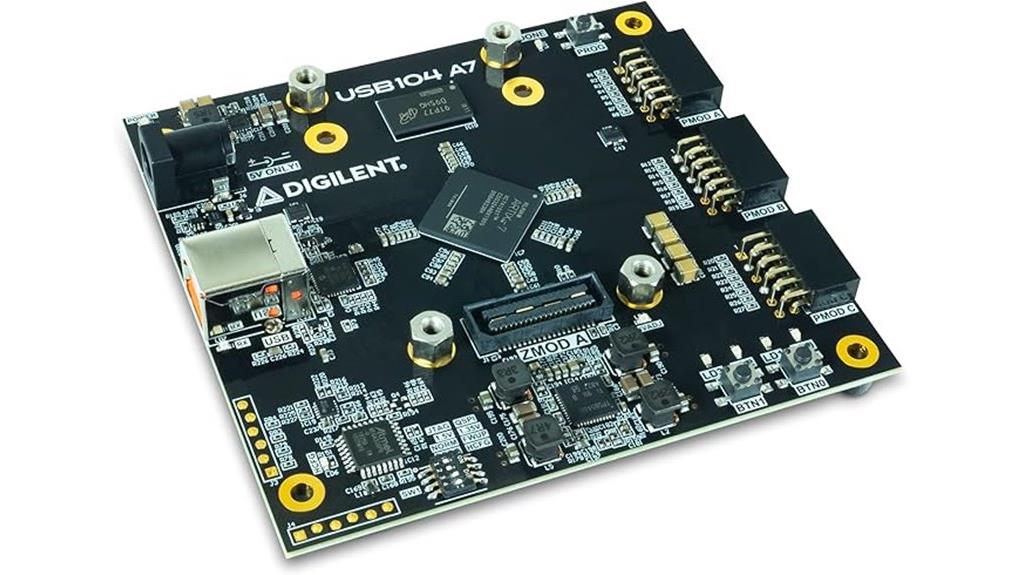
The USB104 A7 stands out as an ideal choice for compact, space-constrained projects requiring high performance, thanks to its industry-standard PC/104 form factor. Measuring just 95.89 mm x 90.17 mm, it’s perfect for stackable PC applications and SWaP-constrained designs. It features a robust Xilinx Artix-7 XC7A100T FPGA, along with 512MB DDR3/DDR3L memory and 16MB Quad-SPI Flash storage. Powered via 5V through a barrel jack or USB, it offers high-speed data transfer with onboard USB hub, JTAG, UART, and DPTI interfaces. Its versatile I/O includes Pmod and Zmod ports, making it suitable for a wide range of advanced, space-efficient projects.
Best For: embedded systems developers and engineers seeking a compact, high-performance FPGA solution for space-constrained, stackable PC applications.
Pros:
- Compact PC/104 form factor ideal for SWaP-constrained projects
- High-performance Xilinx Artix-7 FPGA with ample memory and fast I/O options
- Versatile connectivity including USB, JTAG, UART, Pmod, and Zmod interfaces
Cons:
- Limited to 512MB DDR3/DDR3L memory which may be insufficient for very large data applications
- Requires 5V external power supply, adding to system complexity
- Smaller form factor may limit the number of onboard I/O compared to larger FPGA boards
Factors to Consider When Choosing High‑End FPGA Development Boards
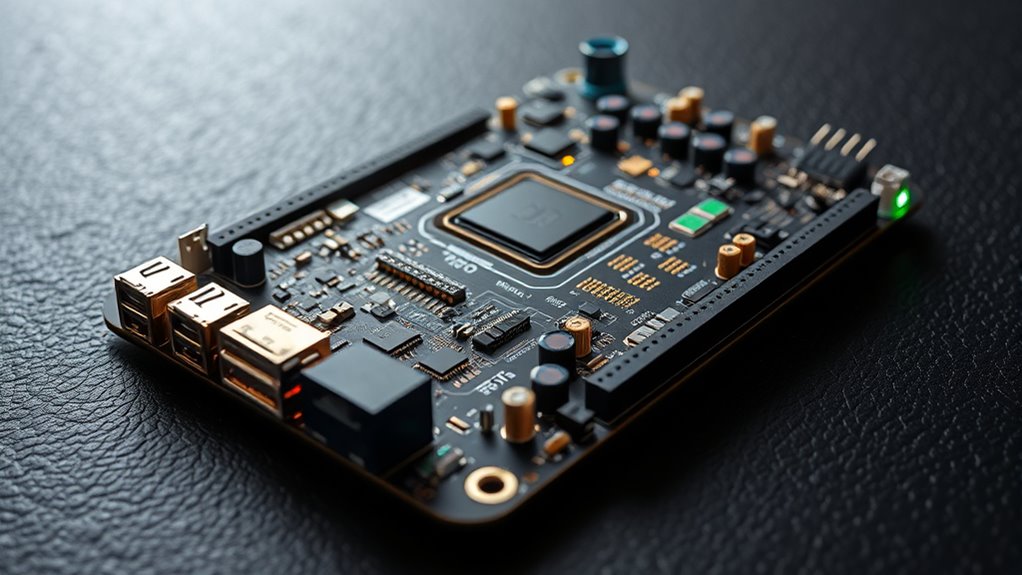
Choosing the right high-end FPGA development board requires careful consideration of several key factors. I look at processing capacity, memory options, I/O ports, power requirements, and the software support to guarantee the board meets my project’s needs. Understanding these points helps me select a platform that delivers both performance and flexibility.
Processing Capacity and Logic
High-end FPGA development boards are distinguished by their impressive processing capacity and logic resources, which are essential for handling complex digital designs. These boards typically feature millions of logic elements, enabling sophisticated algorithms, soft processors, and multimedia processing. The number of DSP slices and embedded memory blocks directly affects their ability to perform high-speed computations and manage data-intensive tasks efficiently. Support for high-frequency clocking—often exceeding 450 MHz—allows for faster data processing and real-time performance. Additionally, multiple high-speed interfaces like PCIe, DDR4, and QSPI Flash boost the board’s data throughput. Larger logic capacity combined with high-speed I/O options provides the flexibility needed for advanced applications, ensuring these boards can handle demanding, multi-faceted projects in 2025.
Memory and Storage Options
When selecting an FPGA development board for advanced projects, memory and storage options play a critical role in guaranteeing ideal performance. High-end boards typically feature large onboard memory, like several megabits of SRAM or gigabytes of DDR3/DDR4 RAM, supporting complex data processing and high-speed operations. Storage choices often include embedded flash memory, such as QSPI or serial flash, for fast reprogramming, configuration, and firmware updates. Some boards also offer high-capacity interfaces like SD card slots or PCIe NVMe SSDs, ideal for extensive data logging, application storage, or multimedia tasks. The amount, type, and bandwidth of memory directly influence the board’s ability to handle large datasets, run sophisticated algorithms, and support multi-tasking. Prioritizing these options assures the board can meet the demands of resource-intensive, high-performance projects.
I/O and Expansion Ports
Memory and storage options set the foundation for a powerful FPGA development board, but the array and arrangement of I/O and expansion ports determine how effectively you can connect peripherals and customize your system. High-end boards often feature over 65 I/O pins, supporting complex peripherals and external devices. They include a variety of expansion ports like Pmod, Zmod, FMC, and PMIC interfaces, offering versatile hardware integration. Multiple dedicated communication interfaces such as USB, Ethernet, and high-speed serial ports enable seamless data transfer and peripheral communication. Additionally, specialized connectors like DDR memory slots and high-speed transceiver ports facilitate advanced data processing and system expansion. The layout and accessibility of these ports are critical for building flexible, compatible setups tailored to specific project needs.
Power and Connectivity
Choosing the right FPGA development board hinges on understanding its power and connectivity options, as these directly impact your project’s performance and flexibility. High-end boards support multiple power sources like USB-C, barrel connectors, or DC adapters, guaranteeing compatibility with various setups. They feature high-speed interfaces such as PCIe, SFP, or QSFP ports, enabling rapid data transfer essential for demanding applications. Adequate I/O capabilities, including GPIO pins, Pmod ports, or FMC connectors, are crucial for connecting peripherals and sensors. Reliable power regulation and filtering circuits safeguard sensitive FPGA components during intensive tasks, maintaining stability. Compatibility with standard communication protocols—JTAG, UART, Ethernet, or USB—ensures smooth programming, debugging, and data exchange. Prioritizing these factors guarantees peak performance and seamless integration for advanced FPGA projects.
Software and Development Tools
Selecting a high-end FPGA development board means considering the software and tools that support your design process. I look for boards that support advanced design environments like Xilinx Vivado or Intel Quartus Prime, which offer all-encompassing features such as synthesis, simulation, and debugging. These tools often include IP cores, testbench generators, and hardware co-simulation, streamlining complex project development. Compatibility with industry-standard environments allows integration with third-party plugins, custom scripts, and automated workflows, boosting efficiency. I also value detailed documentation, tutorials, and example projects that help me learn, debug, and optimize designs within the software ecosystem. Additionally, built-in support for hardware debug interfaces like JTAG enables real-time testing and firmware updates directly from the development environment, ensuring a smooth workflow.
Physical Size and Design
When evaluating high-end FPGA development boards, physical size and design are critical factors that directly impact integration and usability. I consider the board’s dimensions to guarantee it fits within my project’s space constraints, especially for small form factors like PC/104 or compact modules. The layout, including I/O ports, connectors, and mounting holes, must support easy prototyping and seamless integration. I also look for features like stackable headers or modular expansion ports that can grow with my project. Weight and thickness matter, particularly for portable or embedded applications where size and portability are key. Additionally, I check if the design supports effective heat dissipation and power management, which may require larger enclosures or heat sinks to ensure reliable operation.
Support and Documentation
Robust support and thorough documentation are essential when working with high-end FPGA development boards, as they streamline the learning curve and troubleshooting process. I look for boards that offer extensive tutorials, user manuals, schematics, and example projects, which make complex tasks more manageable. Access to comprehensive software tools like IDEs and simulation programs also greatly enhances the development experience. Reliable support channels such as technical forums, direct customer service, and firmware updates are crucial for resolving issues quickly and ensuring long-term usability. Additionally, well-documented pinouts, configuration guides, and clear setup instructions minimize setup time and prevent errors. Overall, strong support and detailed documentation are vital for maximizing the potential of high-end FPGA boards and ensuring project success.
Frequently Asked Questions
Which FPGA Development Board Offers the Best Balance of Power and Cost?
I believe the Xilinx Kintex UltraScale+ FPGA development boards offer the best balance of power and cost. They deliver high performance for complex projects without the hefty price tag of top-tier options. I’ve found them versatile, with plenty of I/O options and fast processing speeds, making them ideal for advanced applications. If you’re looking for a reliable, cost-effective high-end FPGA, these boards are definitely worth considering.
How Do High-Speed I/O Capabilities Influence Board Selection?
Did you know that high-speed I/O can boost data transfer rates by up to 10 times? I always look for boards with robust I/O capabilities because they allow me to handle fast signals and large bandwidths efficiently. When selecting a board, I prioritize those with high-speed transceivers, as they are essential for demanding applications like real-time processing, high-frequency trading, or high-speed communications.
What Are the Key Differences Between FPGA and Soc Development Boards?
I find that FPGA development boards focus primarily on programmable logic, offering flexible hardware customization for tasks like data processing and signal analysis. In contrast, SoC development boards integrate processors and peripherals, enabling running full operating systems and complex applications. The key difference is that FPGAs excel at hardware acceleration, while SoCs provide a complete system-on-chip experience, making each suited for different advanced project needs.
Which Boards Support Advanced Debugging and In-System Programming Features?
Imagine having a high-tech toolkit that whispers secrets of your hardware’s soul—that’s what advanced debugging and in-system programming features offer. I’ve found boards like Xilinx’s Kintex UltraScale+ and Intel’s Stratix 10 excel here, providing JTAG, integrated logic analyzers, and partial reconfiguration capabilities. These features turn complex projects into manageable puzzles, giving me real-time insights and seamless updates, making my work smoother and more precise.
How Scalable Are These High-End FPGA Boards for Future Project Expansions?
These high-end FPGA boards are highly scalable, allowing me to expand projects easily over time. I can add modules, upgrade components, or increase capacity without major redesigns. Their flexible architecture supports future-proof development, ensuring I can adapt to new technologies and project demands. This scalability gives me confidence that my investments will remain valuable and functional as my projects grow more complex and sophisticated.
Conclusion
If you’re enthusiastic to excel with elite FPGA essentials, don’t delay—delve into the diverse development boards that deliver dependable performance. From Cyclone to Zynq, these boards bring boldness, brilliance, and boundary-pushing possibilities. By balancing basics with brilliance, you’ll build better, brighter projects. Remember, choosing the right FPGA board isn’t just about hardware—it’s about honing your hacking skills and harnessing high-end hardware for high-impact innovations.
